|
THE CARTRIDGE COLLECTOR'S EXCHANGE |
| Contents
Cartridges For Sale
Prior Picture Pages: |
Home of the Old Ammo Guy's Virtual
Cartridge Trading Table Featuring a wide range of antique, obsolete, and modern ammunition for collectors Picture Page February 2006 Another great crate..............
I included pictures of an 1873 Union Metallic
Cartridge Company .50-70 shipping crate on the
May 2004
picture page; here's another, this one a Frankford Arsenal .50-70 crate
which held 1000 copper cased bar-primed cartridges when packed at the
arsenal in early 1867. These cartridges would have
been intended for use in the new Model 1866 Springfield Allin's conversion
rifles that were being made available to the Army as replacements for their Civil
War muzzle-loading rifles shortly after the December 1866 Fetterman
massacre. According to the stenciling on the crate, it was packed
in
Both officers whose names are on the crate were West Point graduates and Civil War veterans. Major Edie, while a 2nd Lieutenant, was one of three Ordnance officers assigned to the Allegheny Arsenal in Pittsburgh on September 17, 1862 when a series of explosions destroyed the main building where civilian employees, mostly women and young girls, manufactured paper cartridges for the Union Army. Seventy eight employees were killed and 70 were injured in what is considered the worst civilian disaster during the war. Lt. Edie was then assigned to the Ordnance Department of the Army of the Potomac, serving on General George G. Meade's staff. In December of 1864, he was appointed by Secretary of War Edwin M. Stanton to the military board that was given the task of examining and testing breechloading rifles for the purpose of selecting the one most suitable for adoption by the Army. I believe it was in conjunction with his board duties that Lt. Edie found himself in Omaha in early 1867, perhaps for field tests of the Model 1866 rifle that had been selected. Next, Edie was assigned as the Commanding officer at the Detroit Arsenal in Dearbornville, Michigan, then to the Washington Arsenal in the nation's capital, and finally to the National Armory in Springfield, Massachusetts as the Chief Ordnance Inspector. In July of 1873, Edie was responsible for signing the contract with Colt's Firearms Manufacturing Company for the first 8,000 Single Action Army revolvers. His signature, along with that of Armory Sub-inspector O. W. Ainsworth, also appears on the inspection reports that were made for these revolvers after their delivery to the armory. He died at the age of 35 in October of 1874, seven months after the last of the 8,000 revolvers had been inspected. My information on William H. Lewis is still a bit sketchy. He graduated from West Point in July of 1841, shortly after the conclusion of the Mexican War, and spent most of the next 15 years assigned to the 5th Infantry Regiment on the Western frontier. During the Civil War, he received a Brevet promotion to Major in March of 1864 for gallantry and meritorious service involving the destruction of a Confederate train at the battle of Peralta, New Mexico. In September of 1866, as the commanding officer of a company of the 36th Infantry Regiment, he assumed command of Camp Douglas, Utah Territory. It was here that the ammunition crate was sent in early 1867. Lewis was a Major (Brevet Lt. Colonel) at this time. The 36th Infantry was commanded by Colonel (later Brigadier General) John Gibbon, who took over command of Camp Douglas in 1869, probably in May of that year when the 36th Infantry was consolidated with the 7th Infantry; the resulting unit retaining the 7th Infantry designation. Sometime in the early 1870s, Lewis was transferred to the 19th Infantry, where he was promoted to Lt. Colonel in December of 1873. The 19th Infantry was assigned to reconstruction duties after the Civil War, and headquartered at Jefferson Barracks. They were probably stationed in New Orleans at the time Lewis joined them. In June of 1874, the regiment was transferred to the Department of the Missouri, the headquarters and two companies going to Fort Lyon, Colorado, and the remaining companies going to Indian Territory (later the state of Oklahoma) and Kansas. It would appear that Lt. Colonel Lewis accompanied those bound for Kansas, and he may have been assigned the command of Fort Dodge, Kansas at that time. The troops assigned to Fort Dodge spent much of their time escorting supply trains, guarding the railroad, scouting in central Kansas, and pursuing renegade Indians. The attitudes of the townspeople towards the troops in Dodge City were less than welcoming, with widespread harassment and cheating by businessmen and lawmen alike. In 1877, Lt Col Lewis and a detachment of his troops took over the city for the purpose of resolving this problem. Under a flag of truce that was raised by a town judge, improved treatment of the troops was arbitrated. On September 25th of 1878, Lt Col Lewis, with troops of the 4th Cavalry and 19th Infantry, went in pursuit of a band of Cheyenne Indians led by Chief Dull Knife. The Indians had broken out of the Darlington Agency reservation in Indian Territory in an attempt to make their way to the Dakotas. After two days, the troops overtook the Indians and engaged them Near White Woman Creek in Scott County, Kansas. During the battle, Lt Col Lewis sustained a wound to a femoral artery, from which he died the following day, September 28, while enroute to Fort Wallace, Kansas. He has the dubious distinction of being the last casualty of the last Indian battle in Kansas. Ft. Lewis at Pagosa Springs, Colorado was named in his honor a month after his death. In 1880, the fort was renamed Cantonment Pagosa Springs (and abandoned shortly thereafter) following the establishment of a new Fort Lewis near Durango, Colorado.
. . . . . . . . To be Nitro, or not to be Nitro, that is the question.....
Here's an interesting headstamp on a monstrously long Eley .500 3 1/4" Express. Introduced about 1880 as a black powder cartridge with a standard load of 142 grains of powder and a 440 grain lead copper-tubed express bullet, the .500 3 1/4" developed enough of a following to make the transition to nitro (cordite) powder in the early1890s. This particular case was originally intended for nitro powder, but was modified by Eley Brothers to use with black powder by neatly marking through the NITRO portion of the headstamp with two lines. .
. . . . Three variations of the 7mm Karcher............
. . . . |

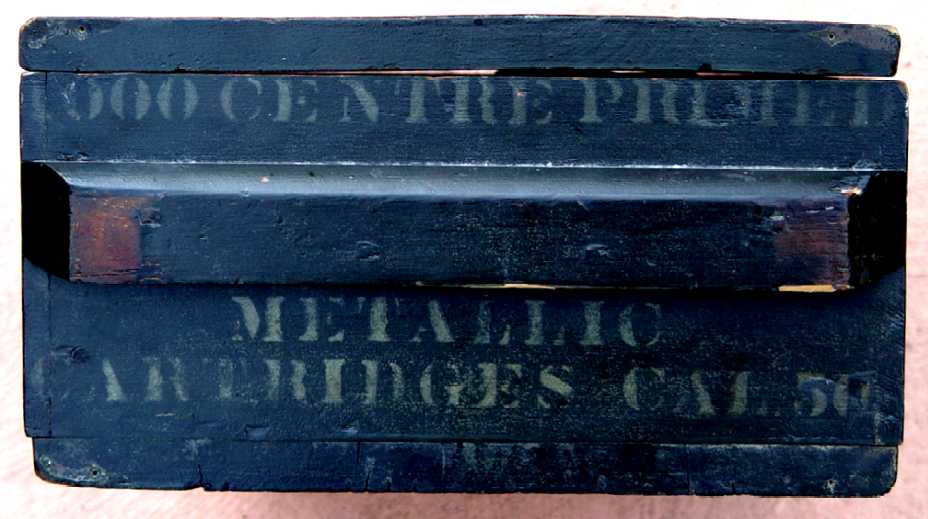
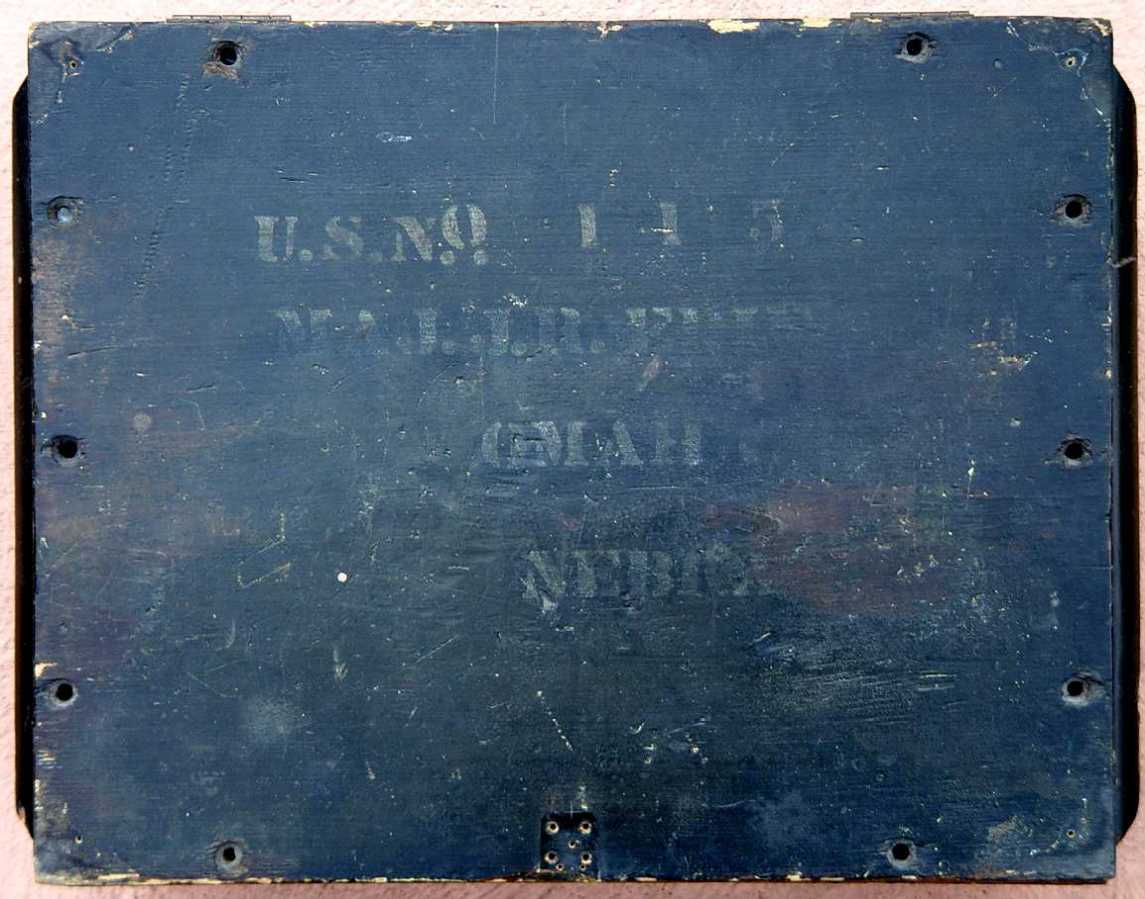 April
of 1867 and shipped to (Brevet) Major John R. Edie, an Ordnance Officer who
was probably temporarily assigned
to the Army's newly formed Department of the Platte in Omaha,
Nebraska. Because the first railroad from the east was completed into Omaha
in January of 1867, this crate, along with other ammunition crates and
possibly crates of the Model 1866 rifles bound for the many Army posts in
Iowa, Nebraska, Wyoming Territory, Utah Territory, and eastern Idaho that
were under the Department's jurisdiction, was probably among the very first
military shipments to make the entire trip from the Frankford Arsenal by rail. From
Omaha, it was shipped to Lt. Colonel William H. Lewis, the commanding officer
of Camp Douglas in Utah Territory. Camp Douglas, located about three miles
east of Salt Lake
April
of 1867 and shipped to (Brevet) Major John R. Edie, an Ordnance Officer who
was probably temporarily assigned
to the Army's newly formed Department of the Platte in Omaha,
Nebraska. Because the first railroad from the east was completed into Omaha
in January of 1867, this crate, along with other ammunition crates and
possibly crates of the Model 1866 rifles bound for the many Army posts in
Iowa, Nebraska, Wyoming Territory, Utah Territory, and eastern Idaho that
were under the Department's jurisdiction, was probably among the very first
military shipments to make the entire trip from the Frankford Arsenal by rail. From
Omaha, it was shipped to Lt. Colonel William H. Lewis, the commanding officer
of Camp Douglas in Utah Territory. Camp Douglas, located about three miles
east of Salt Lake
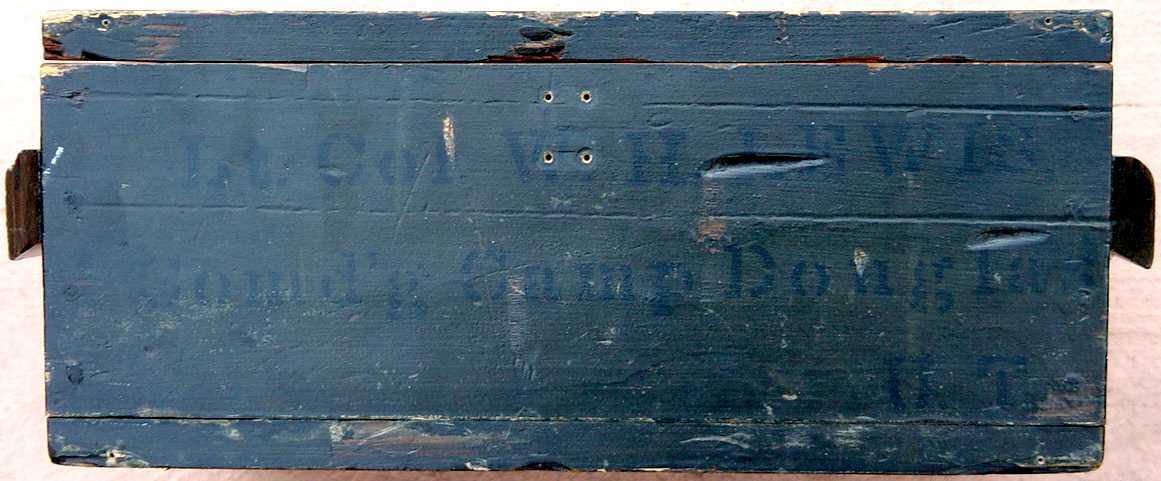 City,
was established in 1862 to provide protection for the overland mail route
and to allow the Army to exercise greater control over the Mormons in the
vicinity.
City,
was established in 1862 to provide protection for the overland mail route
and to allow the Army to exercise greater control over the Mormons in the
vicinity. 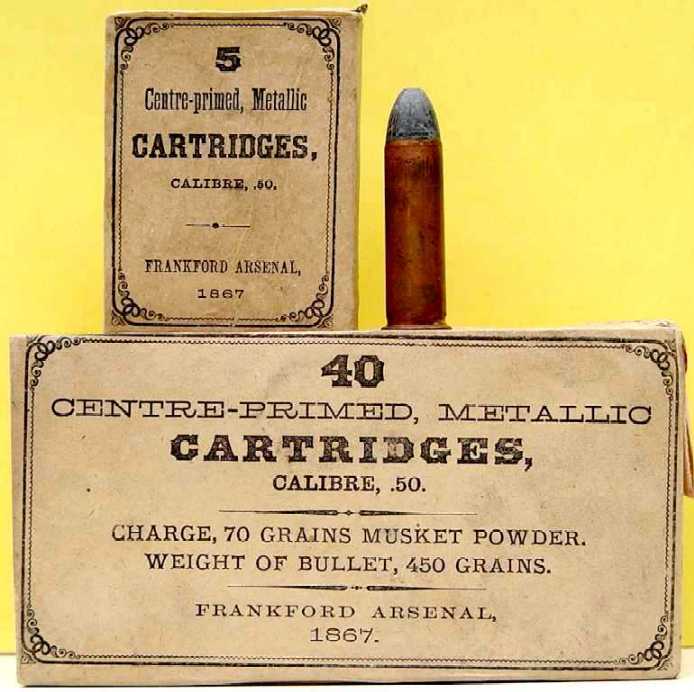 The
crate originally held twenty five boxes, each containing 40 rounds of
ammunition packed in eight small five round boxes. Whether or not there was
a specific purpose for this
unusual packaging is not known, but it is likely to have been just one stage
in the transition of cartridge packaging from the 5 and 10 round packs that
were common in the Civil War to the 20 round boxes that were soon adopted as
the standard for the military, and remain the standard for rifle cartridges
today. Production of the 40 round box probably did not continue for more
than a few months, as 20 round boxes of these same bar-primed .50-70 cartridges
exist with the 1867
date. As a result of the short time they were produced, the 5 round boxes
are only occasionally encountered, and the 40 round boxes are very rarely
seen. When originally found in Utah by the previous owner in the early 1960s,
the crate was full and the top was still secured by 10
large wood screws. Over the years, most of the boxes were sold, including
one of the earliest sales in
March of 1963 of a 40 round box
The
crate originally held twenty five boxes, each containing 40 rounds of
ammunition packed in eight small five round boxes. Whether or not there was
a specific purpose for this
unusual packaging is not known, but it is likely to have been just one stage
in the transition of cartridge packaging from the 5 and 10 round packs that
were common in the Civil War to the 20 round boxes that were soon adopted as
the standard for the military, and remain the standard for rifle cartridges
today. Production of the 40 round box probably did not continue for more
than a few months, as 20 round boxes of these same bar-primed .50-70 cartridges
exist with the 1867
date. As a result of the short time they were produced, the 5 round boxes
are only occasionally encountered, and the 40 round boxes are very rarely
seen. When originally found in Utah by the previous owner in the early 1960s,
the crate was full and the top was still secured by 10
large wood screws. Over the years, most of the boxes were sold, including
one of the earliest sales in
March of 1963 of a 40 round box
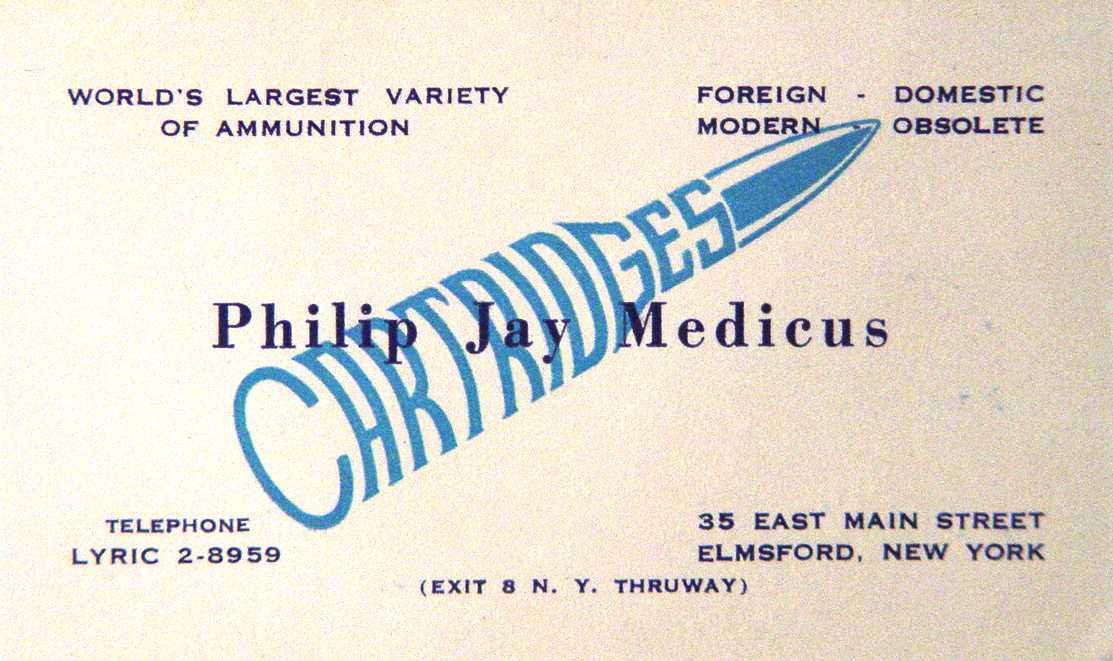 and a 5 round box to
the late Phillip J. Medicus, a New York cartridge dealer, for $135. I've
included a shot of his business card, which was in his letter sent to the owner
of the crate regarding the
purchase. Mr. Medicus provided pictures of his boxes to Frank Wheeler,
editor of the cartridge column in The Gun Report magazine, who
included them in his column in the August 1963 issue. Surprisingly, the crate still contains several of the full 40 round boxes.
One of these boxes was open, allowing the eight 5 round boxes to be easily
removed and photographed. The boxes have light staining and minimal paper
loss; the cartridges are pretty much in as new condition, with many of them
displaying wrinkles in the sides of the soft copper cases or case mouth deformities, suggesting that the Armory had not yet
worked out all of the kinks in the production of
and a 5 round box to
the late Phillip J. Medicus, a New York cartridge dealer, for $135. I've
included a shot of his business card, which was in his letter sent to the owner
of the crate regarding the
purchase. Mr. Medicus provided pictures of his boxes to Frank Wheeler,
editor of the cartridge column in The Gun Report magazine, who
included them in his column in the August 1963 issue. Surprisingly, the crate still contains several of the full 40 round boxes.
One of these boxes was open, allowing the eight 5 round boxes to be easily
removed and photographed. The boxes have light staining and minimal paper
loss; the cartridges are pretty much in as new condition, with many of them
displaying wrinkles in the sides of the soft copper cases or case mouth deformities, suggesting that the Armory had not yet
worked out all of the kinks in the production of
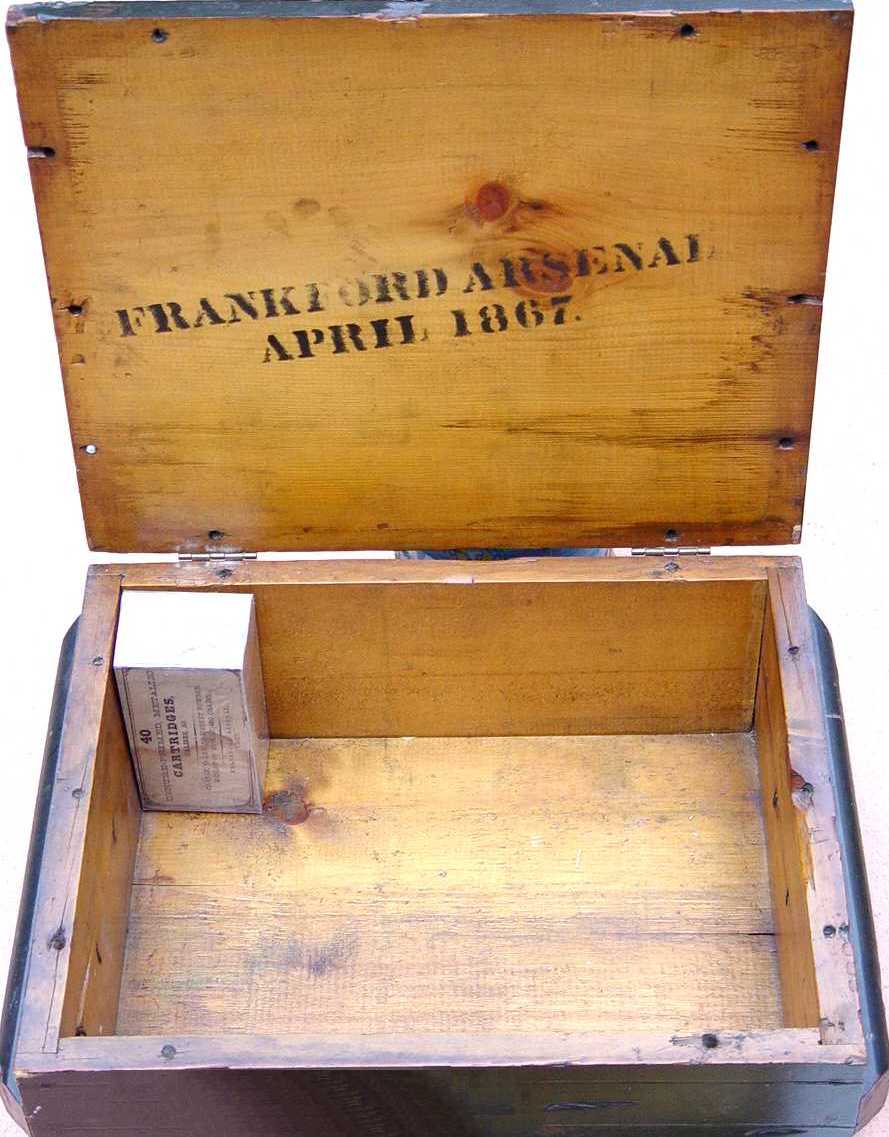 its
new centerfire cartridges. The picture here shows how the 40 round boxes
would have been oriented in the crate, allowing five
rows of five boxes to be packed securely. The boxes were in the crate for so
long that
lines can be seen on the inside bottom
and sides of the wood indicating where the boxes were. One of these faint
lines can be clearly seen on the side of the crate just to the right of the box in this picture.
The hinges that can be seen on the crate in this picture are not original, but were added by the
previous owner.
its
new centerfire cartridges. The picture here shows how the 40 round boxes
would have been oriented in the crate, allowing five
rows of five boxes to be packed securely. The boxes were in the crate for so
long that
lines can be seen on the inside bottom
and sides of the wood indicating where the boxes were. One of these faint
lines can be clearly seen on the side of the crate just to the right of the box in this picture.
The hinges that can be seen on the crate in this picture are not original, but were added by the
previous owner. 
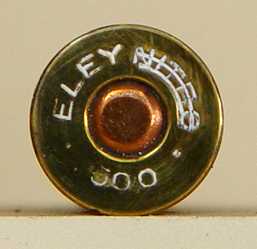
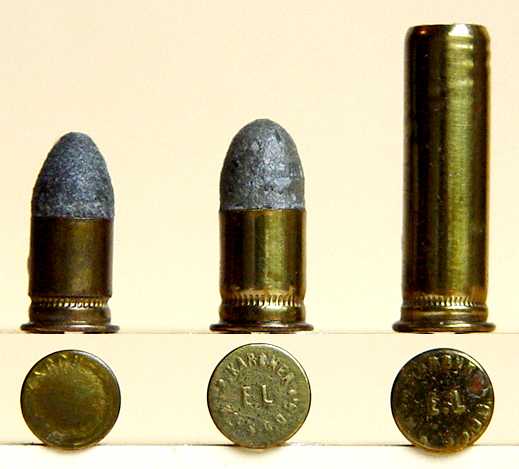 Here
are three variations of the inside-primed 7mm Karcher cartridge, all with a
raised P.KARCHER Bte S.G.D.G. E.L. headstamp. The first two have lead
bullets of different weights and profiles; the third being a shot load with
a paper wad. The knurled cannelure in the case holds the primer anvil in
place. These appear to be nothing more than inside primed 7mm French
cartridges. I have no information on the firearm these cartridges were intended
to be used in.
Here
are three variations of the inside-primed 7mm Karcher cartridge, all with a
raised P.KARCHER Bte S.G.D.G. E.L. headstamp. The first two have lead
bullets of different weights and profiles; the third being a shot load with
a paper wad. The knurled cannelure in the case holds the primer anvil in
place. These appear to be nothing more than inside primed 7mm French
cartridges. I have no information on the firearm these cartridges were intended
to be used in.